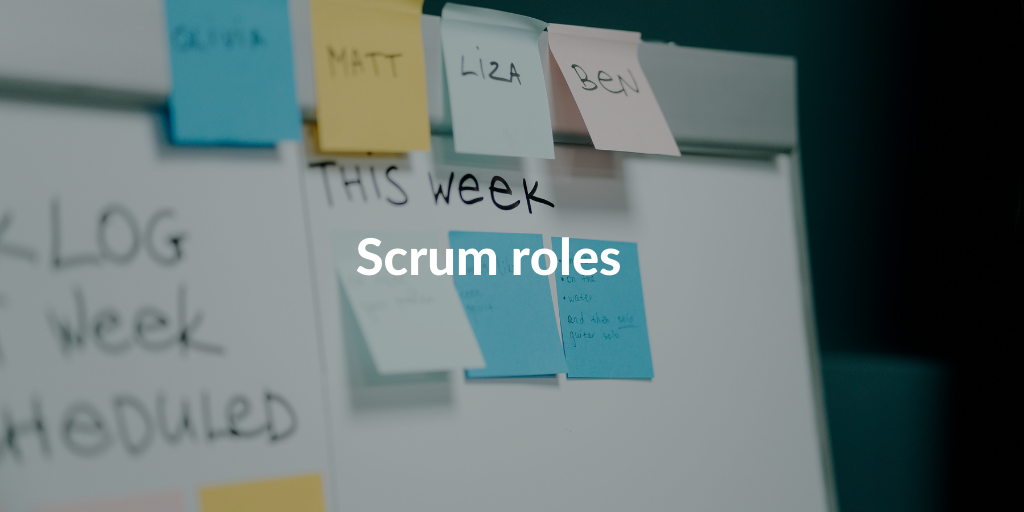Scrum is a popular Agile Framework that helps teams function efficiently. It does so through predefined roles that provide structure, while still allowing for flexibility. Scrum is a framework that helps put the team into place and helps deliver works effectively. Scrum provides a structure for meetings, responsibilities and artifacts. The goal of the framework is to create a fundamental sense of structure underneath shifting skills and project needs. Scrum is pretty flexible and can be adapted to the situation of the company.
The Scrum Team
The dedicated Scrum roles are enough to describe the minimum responsibilities of the Scrum team. The size of the team and the specific skills depend on the project and the project phase, it can change overtime. The predefined Scrum roles are the following; the Scrum Product Owner, the Scrum Master and the Scrum Developer(s).
The Scrum roles complement one another. Success can only come from embracing all three roles and giving them the opportunity to work together closely. All roles are unique and success is reached if they work together in synergy with two-way respect.
The Scrum Product Owner
The Scrum Product Owner is the professional responsible for maximizing the value of the product resulting from the work of the Development Team or, in other words, for maximizing business value for the project. He or she is responsible for articulating customer requirements and ensuring the business justification throughout the project. We can say this role embodies the voice of the Customer.
The Product Owner must always maintain a dual view, understanding and supporting the needs and interests of all stakeholders, while also understanding the needs and workings of the Scrum Team. The Scrum Product Owner is, among other things, responsible for;
- Managing the Scrum backlog
- Managing Stakeholders
- Managing releases
In short, the Scrum Product Owner is the hub of business value. Read all about the Scrum Product Owner in this dedicated blogpost.
The Scrum Master
The Scrum Master is the professional who coaches the team towards the adoption of the Scrum Framework. The core responsibility of a Scrum Master is to lead the Scrum Team to the correct understanding and enactment of the Scrum theory, practices and rules.
He/she is the professional responsible for ensuring that the Agile philosophy is understood and enabled inside the whole organisation (that is the reason why is preferable that the Scrum Master belongs to the organization instead of being a freelance).
The main responsibility of the Scrum Master is being a process facilitator for the Product Owner and for all the Scrum Team. The Scrum Master is, among other things, responsible for;
- Promoting values
- Ensuring transparency
- Enabling self-organization
- Planning sprints
In short, the Scrum Master is the protector of everything Scrum. Read all about the Scrum Master in this dedicated blogpost. You can find more information about the Scrum Master exam here.
The Scrum Developer
The Scrum Developer is the professional responsible for creating the project deliverables, together with the entire Development Team. The Development Team is made by professionals who do the work of delivering a potentially releasable increment of “Done” product at the end of each Sprint.
Each Scrum Developer is responsible for delivering a functional element (or chunk) of the product at the end of each sprint. The Scrum Developer is also responsible for;
- Delivering work
- Estimating the user stories in the sprint backlog
- Understanding the business requirements
- Ensuring transparency
- Being organized
In short, the Scrum Developer team is the autonomous collective. Read all about the Scrum Developer in this dedicated blogpost.
Stakeholders
The Stakeholders are not a direct part of the Scrum team, but influence highly the course of events. The stakeholder has to keep a healthy relationship with the Scrum Product Owner to share the details of the project. The Stakeholder provides regular input to the Product Owner and prioritizes work effectively with the Product Owner, to ensure the project development.
The Stakeholder in a Scrum Project is responsible for;
- Regular input to queries of the Scrum Product Owner
- Conveying his wishes and concerns with the Scrum Product Owner
- Share all possible details with the Scrum Product Owner
Do you want to get a certification in one of these roles? QRP International offers both the Scrum Master training and the Scrum Product Owner training. Find out more on our website or write us.
Source: The Scrum Guide








